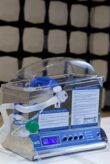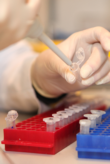The COVID-19 pandemic demonstrates that health systems in many countries – developed and developing – were not prepared for such a crisis. Since 2005, several organisations have warned about the consequences of pandemics, issuing recommendations to prepare for critical health situations (WHO 2005, World Economic Forum 2006). However, in many countries few of these recommendations were followed. In September 2019, before the outbreak in China, a study by the Johns Hopkins Centre for Health Security stated that in many countries a lot remained to be done to improve preparedness for pandemics. When the COVID-19 pandemic appeared, most countries had to improvise, with the threat that it would overwhelm their health systems, depending on the timing and extent of their measures and the state of their national health systems. National trade restrictions, interrupting supply chains and impeding medical and protective equipment exports, have also exacerbated the situation.
Leading industrial countries were able to mobilise their manufacturing potential, technical competencies and well-developed quality infrastructure (including metrology, standardisation, accreditation, calibration and testing labs, certifiers and inspections) to ensure quality medical devices, testing material, procedures and results. But what about developing countries? They have had to confront similar problems, with mostly weak health systems and fragmented quality infrastructure systems, oriented primarily at meeting international export market standards, but often not for health requirements.
At the beginning of the outbreaks, developing countries were able to do very little testing, with long waiting pe-riods to get test results and issues in terms of accuracy. The WHO requires 95% accuracy, but unofficially in Latin America it is assumed (differing from country to country) that up to 30-40% of test results have been in-accurate. In the case of a false SARS-CoV2 positive result, the person has to undergo quarantine. But what is the consequence of a false SARS-CoV2 negative result? The person goes on infecting others without knowing it.
So, in what areas does quality infrastructure of health systems need strengthening in developing countries? And how?
Sufficient and certified personal protection equipment (PPE)
The lack of PPE – masks, gloves, safety glasses and shoes, hard hats and full body suits – that meets the WHO or the US Food and Drug Administration’s quality requirements is a serious problem, especially for medical personnel. The high number of infected medical personnel and protests in many countries (e.g. in Brazil, Mexico and Peru) against insufficient stocks of adequate PPE, demonstrate the severity of the issue. When imports are not a solution, domestic production is unavoidable. But what can be done if suppliers lack or are not able to meet quality standards? National Metrology Institutes and National Standardisation Bodies have stepped in and helped overcome these gaps. LACOMET, Costa Rica’s national metrology institute, is using its 3D-printers to manufacture masks and gloves. In Ecuador, national standardisation body INEN developed capacity to certify PPE according to international requirements. However, these stopgap interventions cannot substitute developing sufficient PPE production capacity, embedded in national quality infrastructure.

MIT open-source and low-cost mechanical ventilator which serves as technical base for ventilators now developed in some developing countries.
Infrared thermometers that meet technical standards and guides
Measuring body temperature with infrared thermometers has become a mass phenomenon. People’s temperatures now have to be taken in many different places (supermarkets, drugstores, airports). Initially, there were not enough infrared thermometers and little knowledge on how to use them properly. Another problem is that many national metrology institutes have neither the equipment nor the experienced personnel to use infrared thermometers. National metrology institutes in many developing countries have turned to leading institutes like NIST (USA), PTB (Germany) or NIM (People’s Republic of China) for training and support in using infrared thermometers. PTB and NIM, for example, have held videoconferences to give practical calibration hints to their colleagues in Africa, Asia and Latin America. The national metrology institutes of Spain (CEM), Brazil (INMETRO), and LACOMET (Costa Rica), have elaborated guidelines on calibrating and using infrared thermometers.
Mechanical ventilators that meet quality requirements
Calibration of control units for the increasing number of mechanical ventilators is a significant challenge. Production capacity of leading manufacturers like the United States, Germany or the People’s Republic of China is not enough to satisfy increasing demand due to the crisis. Because of shortages, some countries, like Bolivia, bought equipment from intermediaries that was either incomplete or did not work properly, and involved cases of corruption. Other governments began to support the domestic production of ventilators, for instance in South Africa, Argentina, Chile or India. The approval of prototypes by national health authorities requires the calibration of measurement instruments, especially sensors and valves. Without correct volume and pressure control measurement, the ventilation equipment could be putting a patient’s life at risk. But because of significant oil and gas production, export and consumption in these countries, existing calibration facilities had primarily been designed for big, rather than small volumes and pressures. In developing countries, only few national metrology institutes have this competence. These metrology institutes, as well as those in more advanced countries, should support others with less experience, for instance through distance training or technical co-operation.
Quality management systems in clinical laboratories and reference materials
In developing countries, only a handful of laboratories have a quality management system accredited by ISO 15189 requirements for quality and competence, which is important for getting accurate test results. Other standards and best practices are necessary for biocompatibility, electromagnetic compatibility or risk management. The scale of the crisis has meant having to involve more (private and public) laboratories in testing activities that were not initially prepared to meet quality management requirements. In Chile for instance, five laboratories have had to suspend their activities while they updated their internal quality management to meet the national health authority requirements. Supply-chain disruptions have also caused a shortage of reference materials for testing. They serve to determine and compare the composition of samples taken from patients. Leading metrology institutes, mostly in industrialised countries, produce these reference materials. In Mexico, CENAM is working on this task and could help address shortages in the region.
To sum up, in most developing countries, quality infrastructure for health systems is weak and often unable to satisfy minimum requirements. To be prepared for the next pandemic, it is urgent to make a number of changes.
First, national health authorities have to prioritise and allocate adequate resources for quality infrastructure systems for the health sector. This would enable emergency responses and the upgrading of existing institutions and competences.
Second, co-operation between health authorities and those in charge of quality infrastructure has to be strengthened. The health sector has to work closely with national metrology institutes, standardisation bodies and accreditation bodies to overcome gaps in calibration procedures, standards and accredited conformity assessment for health-related purposes.
Third, many developing countries lack the financial and technical resources to implement complete quality infrastructure for their national health systems. International and regional co-operation, especially through regional quality infrastructure organisations, should play a more prominent role to help improve technical competences and coordinate countries’ efforts.
International co-operation with leading quality infrastructure institutions could accelerate this process, transferring experiences and leveraging digitalised instruments to help developing countries upgrade their quality infrastructure for health systems and effectively combat SARS-CoV2.
Source:
Images © MIT Open Source








